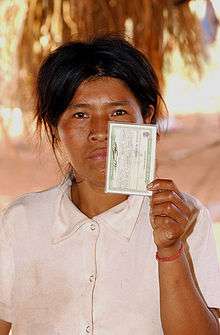Voter ID laws
A voter ID law is a law that requires a person to show some form of identification in order to vote or receive a ballot for an election. In jurisdictions requiring voter IDs, the voters must present a photo ID. Because of perceptions of a differing means to obtain identification on the basis of socioeconomic status, age, or race, some people consider these laws as controversial.

Examples
Australia
In Australia, where voting is compulsory for all adult citizens, no form of ID is required to cast a ballot at an election; instead, voters are asked three questions before being issued a ballot, so that they can be checked off the electoral roll: (1) what is your full name; (2) where do you live; and (3) have you voted before in this election?[1] On election day, voters can vote at any polling place in their state of residence, and at selected polling places in other states.[2]
Brazil
In Brazil voting is compulsory to all citizens between 18 and 70 years old.[3] To vote, all citizens must:
- Be registered to vote
- Report in person to the voting section[4]
- Present an official identity document with photo, usually the regular ID card (cédula de identidade)
Since 2006 the Brazilian Electoral Justice is re-registering voters with biometric identification. In the 2014 elections more than 22 million voters out of 141 million[5] will be identified by fingerprints.[6]
Canada
Federal elections
In Canada, the Federal government mails an Elections Canada registration confirmation card, which the voter takes to the polling station. The card tells the individual where and when to vote. Voters must prove their identity and address with one of three options:[7]
- Show one original government-issued piece of identification with photo, name and address, like a driver's license or a health card.
- Show two original pieces of authorized identification. Both pieces must have a name and one must also have an address. Examples: student ID card, birth certificate, public transportation card, utility bill, bank/credit card statement, etc.
- Take an oath and have an elector who knows the voter vouch for them (both of whom must make a sworn statement). This person must have authorized identification and their name must appear on the list of electors in the same polling division as the voter. This person can only vouch for one person and the person who is vouched for cannot vouch for another elector.
Provincial elections
However, in some provinces a voter must establish their identity by presenting a health insurance card, driver’s license, Canadian passport, certificate of Indian status, or a Canadian Forces ID card.[8] These are all photos IDs.
Germany
Germany uses a community-based resident registration system. Everyone eligible to vote receives a personal polling notification by mail, some weeks before the election. The notification indicates the voter's precinct polling station. Voters must present their polling notification and if asked a piece of photo ID (identity card (compulsory in Germany), passport, form of identification). As a rule identification is not required other than by the polling notification. If the voter can not present the notification, a valid ID and an entry in the register of voters can qualify for voting.[9][10]
Netherlands
The registration office of each municipality in the Netherlands maintains a registration of all residents. Every eligible voter receives a personal polling notification by mail some weeks before the election, indicating the polling station of the voter's precinct. Voters must present their polling notification and a piece of photo ID (passport, identity card, or drivers license (a passport or ID is compulsory from the age of 14)). Such photo ID may be expired but not by more than five years.[11]
Switzerland
In Swiss cantons (i.e. the subnational political level in Switzerland) that still use the Landsgemeinde or cantonal assembly; Historically, or in Appenzell until the admission of women, the only proof of citizenship necessary for men to enter the voting area was to show their ceremonial sword or Swiss military sidearm (bayonet); this gave proof that you were a freeman allowed to bear arms and to vote. Women, and men who choose to do so, may show their voting card instead.[12]
United States
The Twenty-fourth Amendment to the United States Constitution prohibits the conditioning of the right to vote in federal elections on payment of a poll tax or other types of tax. However, many states have some form of voter ID requirement, which have been allowed to stand by the Supreme Court.[13][14]
Proponents of voter ID laws in the United States claim they are necessary to maintain the integrity of elections. Critics of such laws claim that they keep certain—mostly lower economic class—voters from the polls, and cite the lack of evidence of significant voter fraud.
See also
References
- ↑ Australian Electoral Commission: Polling
- ↑ Australian Electoral Commission: Ways to Vote
- ↑ Timothy J. Power: Compulsory for Whom? Mandatory Voting and Electoral Participation in Brazil, 1986–2006, in: Journal of Politics in Latin America. S. 97–122
- ↑ Zonas eleitorais, 25 de janeiro de 2013 – 16h05 (in Portuguese)
- ↑ Biometria e urna eletrônica, 21 de junho de 2013 – 18h31 (in Portuguese)
- ↑ The Biometrical System in Brazil, 27 de junho de 2013 - 18h29
- ↑ Elections.ca
- ↑ Monvote.qc.ca.en
- ↑ https://www.bundeswahlleiter.de/de/glossar/texte/Ausweispflicht.html
- ↑ Bundeswahlordnung § 56, paragraph 3
- ↑ "Elections 2012 (in Dutch)". Retrieved September 16, 2012.
- ↑ Appenzell.info
- ↑ "Voter identification: First, show your face". The Economist. September 17, 2011. Retrieved November 12, 2011.
- ↑ "Supreme Court lets Wisconsin voter ID law stand". USA Today. March 23, 2015. Retrieved December 4, 2015.